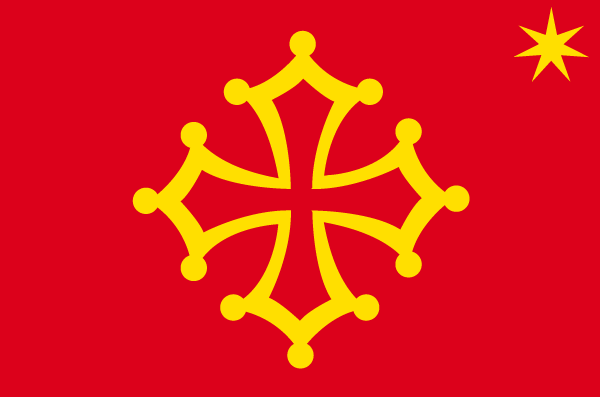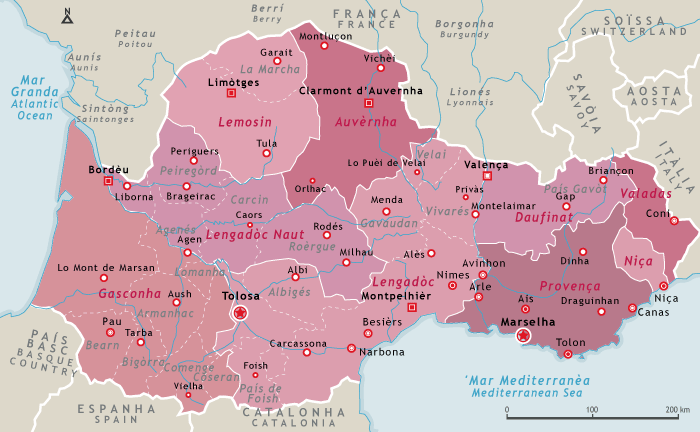Occitania, a vast multifaceted area

Occupying a central space in Latin Europe, Occitania is a fully defined nation without official recognition, where a strong sense of southern identity persists despite the decline of the language.

The Occitan flag is made up of an Occitan cross (or Cross of Forcalquier, cross of the count of Toulouse), gold in colour on a red background. In the right-hand corner a seven-pointed star is often found in memory of the Occitan Félibrige literary movement.
Thirty-three French departments in eight administrative regions, Val d’Aran in the autonomous government of Catalonia and eleven Italian valleys, Occitania is a genuine central European area that occupies a third of the French state, from the Alps to the Pyrenees. For a long time, Occitania was a genuine bridge between the north and south of Europe. It was the cradle of the European Renaissance of the Middle Ages, seeing the birth of the poetry of the Troubadours, who reinvented love and exported the Oc language throughout Europe. Nowadays, an Occitan-Catalan Euroregion has strong southern impulses in part of the territory, even if Provence prefers to look towards Piedmont and the Alps.
The term “Occitanian” has been used for a relatively short time (20th century) but its existence has been confirmed since 1290 to indicate ownership of the Oc language by the king of France. Today, the term “Occitan”, is used by the majority of activists.
The language is one of the primary issues advocated by activists. Demonstrations in favour of this brought together 15,000 in Carcassonne in 2005 and more than 20,000 people in Béziers in 2007. Further regions developed political language projects in favour of the Occitan language (Midi-Pyrénées, Languedoc-Roussillon, Aquitaine, Rhône-Alpes but not in Provence, despite being the birthplace of the Occitanian linguistic and cultural renaissance in the 19th century). All regions combined, 80,000 students learn (or are aware of) Occitan today.

Identity card

| Name | Occitània | Occitan , Catalan Occitanie | French Occitania | Italian, Castilian |
| Population | 16,227,241 inhab. (2006-2008) |
| Area | 190,000 km² |
| Languages | Occitan | Occitan (without official status in France, status in Spain and Italy) Français | French Italiano | Italian Castellano | Castilian Català | Catalan (official) |
| Number of native speakers | 500,000 to 3,000,000 | Occitan |
| State of guardianship | France, Italy, Spain |
| Official status | Regions without autonomous status in France, Catalan country for the Val d’Aran, valleys of the Piedmont regions and Liguria for Italy |
| Capital | Tolosa | Occitan (Toulouse) & Marseilha | Occitan (Marseille) |
| Historic religion | Roman Catholic |
| Flag | Crotz occitana | Occitan (Occitan Cross) |
| Anthem | Se canta | Occitan (If it Sings) other anthems are used |
| Motto | None |

Timeline

- 123 BC • Conquest of the south of Gaul by the Romans
- 466 • The Visigoths, under the reign of their King Euric the Great (466–84) dominate their territory stretching to southeastern Europe.
- 1209 • Pope Innocent III launches a crusade against the Albigensian heretics. In 1213, the Occitan defeat at the Battle of Muret is a symbol of the end of Occitan independence.
- 1790 • Abbé Grégoire launches his linguistic survey on “Patois”. The Occitans are among the most numerous to respond.
- 1854 • Birth of the Maillane of Félibrige, a literary movement founded by Frédéric Mistral (Nobel Prize for Literature in 1904).
- 1907 • Revolt of the winegrowers in Languedoc. 70,000 people demonstrate in Montpellier in June, referring to the Crusade against the Albigensians.
- 2004 • 150 years of Félibrige. The Midi-Pyrénées and Languedoc-Roussillon create a Euroregion with the Catalan and Aragon regions.

Brief history

The crusade against the Albigians (1208–49) was the only crusade in European territory. It was decided upon by the Pope and the King of France to re-evangelise the county of Toulouse, which housed many Albigian “heretics”, or Cathars (the name dates from the 19th century). It was primarily so that the King of France could annexe the southern territories. The inhabitants of Béziers were all massacred on 22 July 1290 and the atrocities would continue. The Occitano-Catalan troops (the count of Toulouse went to the king of Aragon-Catalonia) were defeated at Muret, in 1213, and Pierre II of Aragon was killed. The crusades led by Simon of Montfort increased their power in the region. A truce was imposed by the Pope in 1214, but Count Raymond VI raised an army in 1216 to regain Toulouse. Despite a series of victories, they were finally defeated and a peace treaty was signed in Paris in 1219. It signified the beginning of the annexing of the Occitan territories by France.

Geography

Occitan space stretches between two seas, the Mediterranean and the Atlantic Ocean, and on three mountainous massifs, the Alps, Massif Central (or Northern in Occitan manuals) and the Pyrenees. Among the major rivers, there is the Garonne, the Rhône, the Loire, and the source of the Pô. Occitania is the largest stateless nation in Europe, with an area of 190,000 km² (which is the equivalent of about a third of the territory of France). Economically important plains are present around the Rhône and Garonne valleys. The terrain defines cultural and agricultural regions that are quite different, even if the mountains have never constituted the real language borders: the Val d’Aran is situated on the southern slopes of the Pyrenees, and Occitan is spoken as far as the plain of the Pô Valley in Italy.



Language

Occitan
Occitan is a Romance language belonging to the Gallo-Roman group, with French, Franco-Provençal and, of course, Catalan; a language with which certain Occitan dialects (Languedocian but also Provençal in particular) allow very good inter-comprehension. Born around the year 1,000, the language distinguishes itself from French by the more conservative traits: clearly, the Occitan language remained close to Latin and even closer to other Roman languages (Italian, Spanish, etc.). There are three variants, Gascon in the west, Languedocian-Provençal in the middle and south-east and Limousin-Auvergne-Upper-Provençal in the north. The number of native speakers is generally estimated as being between 500,000 and 7 million (taking into account the speakers knowing the language but not speaking it regularly), at the high end nearly 20% of the population (census data does not allow greater accuracy). It is spoken in the whole territory of Occitania, in the Val d’Aran in Catalonia and the valleys of the Piedmont Alps, where it has official status as a minority language. France refuses to give prominence to regional languages, where the Occitan language is now a concern for the future. Certainly the only encouraging fact is the 80,000 students who learn it or are starting to learn. However, its place in the media, on road signs and in administration is poor.

Politics now

The Occitan language is now split between three European states where its politcal status varies considerably. In France, Occitania is divided between 33 departments and 7 regions. No particular status encompasses this area. The status of the Occitan region is that of the French regions: they have limited power, no special skills or political autonomy and cannot conduct cultural or linguistic policy that would violate the French constitution, which states that French is the only language of the Republic (although the legislation may soon change). In Italy, the Occitan minority has been recognised by law since 1999, and individual municipalities decide whether or not they belong to a minority. The 11 Occitan valleys of Italy are attached to the Piedmont and Liguria regions. In Spain, the Val d’Aran has been recognised by Catalonia since 1991 and has its own institutions (Conselh Generau). The Occitan Party is the most active of autonomist parties. It is present in a few municipalities and now has five representatives at regional level.
Occitan parties
- Partit Occitan (POC) / Occitan Party (Autonomist progressive)
- Partit de la Nacion Occitana (PNO) / Party of the Occitan Nation (Separatist)
- Libertat / Freedom (Revolutionary)

